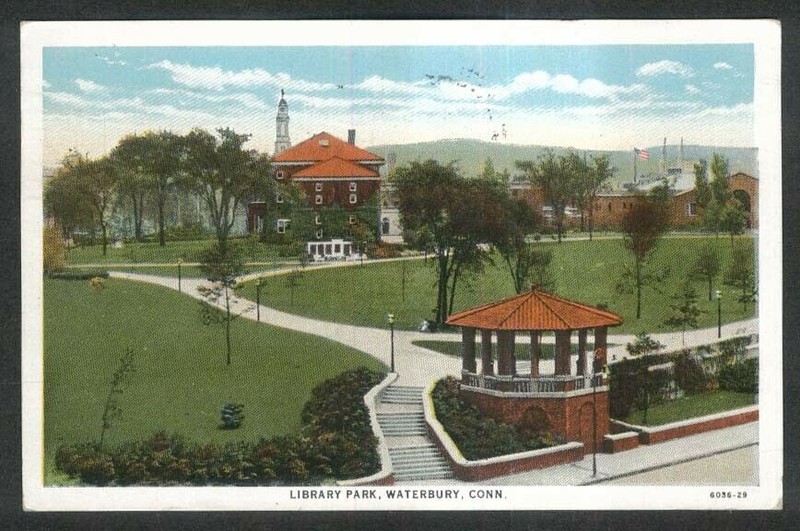Silas Bronson Library and Library Park
Introduction
Text-to-speech Audio
Images
Old Silas Bronson Library and Library Park, 1933

Backstory and Context
Text-to-speech Audio
From Raechel Guest's "Library Park History." For a more complete history of Library Park (including many wonderful historic photographs), read her article at http://waterburythoughts.blogspot.com/2018/03/library-park.html
"When the village of Mattatuck (now Waterbury) was developed in the 1670s, Grand Street formed the southern-most boundary of the small community's residential area, with pastures for livestock in the meadows beyond. A fence ran along the boundary...The village burying ground was located on the outside of the Grand Street fence, where the library building is today. Over the course of two centuries, the burying ground was subdivided into four sections: one for the Congregational church, one for the Episcopal church, one for people of color, and one for Catholics."
"The Grand Street burying ground became run down by the 1880s. Although there were still families actively caring for areas of the cemetery, much of it became overgrown with weeds. Despite being surrounded by stately homes, the cemetery was 'daily marred by acts unfit to mention' and the tombstones were being vandalized and even stolen...The City of Waterbury took ownership of the burying ground in 1891 with the intention of converting it into a park."
"Of the more than 750 graves in the cemetery, the City paid for 63 to be relocated. An unknown number of others were exhumed at private expense...Most of the graves were left in place, the tombstones buried lying flat a few feet under the surface in random locations. Those with no tombstones were also left in place..."
In the early 1900s, Library park was extended. A small neighborhood was razed to make way. By the 1930s, the park had been renovated to include the gazebo and brick retaining wall seen in the postcard on this page. The current library building replaced the original brick library in the 1960s.
Sources
http://www.fortunestory.org/religionandslavery/burial.aspBurial Locations: Waterbury's Early Cemeteries. Fortune's Story. Accessed September 23, 2017. http://www.fortunestory.org/religionandslavery/burial.asp.
Anderson, Joseph. The Town and City of Waterbury, Connecticut from the Aboriginal Period to the Year Eighteen Hundred and Ninety-Five. Vol. III. New Haven, CT. Price & Lee, Co., 1896.
Guest, Raechel. "Library Park History," March 25, 2018. http://waterburythoughts.blogspot.com/2018/03/library-park.html. Accessed November 25, 2020.
https://picclick.com/Library-Park-Waterbury-CT-postcard-1933-392997863660.html
